Analyzing Equality, Diversity, and Inclusive Practices in the UK
VerifiedAdded on 2024/06/03
|28
|7112
|372
Report
AI Summary
This report provides a detailed analysis of equality, diversity, and inclusive practices within the UK context. It defines equality and diversity, highlighting the protected characteristics under the Equality Act 2010, and examines the benefits of promoting these principles for individual learners. The report reviews the impact of personal, social, and cultural factors, as well as cognitive, physical, and sensory abilities, on learning. Furthermore, it discusses actions that undermine equality and diversity, recommending modifications to systems and structures to foster inclusion. Legislation, employment regulations, and codes of practice relevant to promoting equality are defined, and the report reflects on how these measures protect learners from harm. The role of inter-agency collaboration in promoting diversity is explored, and the influence of policy and regulatory frameworks on organizational and individual inclusive practices is examined. The report also summarizes the individual's role and responsibilities in promoting inclusive practice, reviews the features and benefits of an inclusive learning environment, and analyzes ways to promote inclusion and value individual learners. Effective communication strategies, the impact of individual behavior on organizational culture, and the roles of various professionals involved in inclusive practice are also addressed, along with points of referral and strategies for effective liaison. Finally, the report touches upon safeguarding and welfare issues.
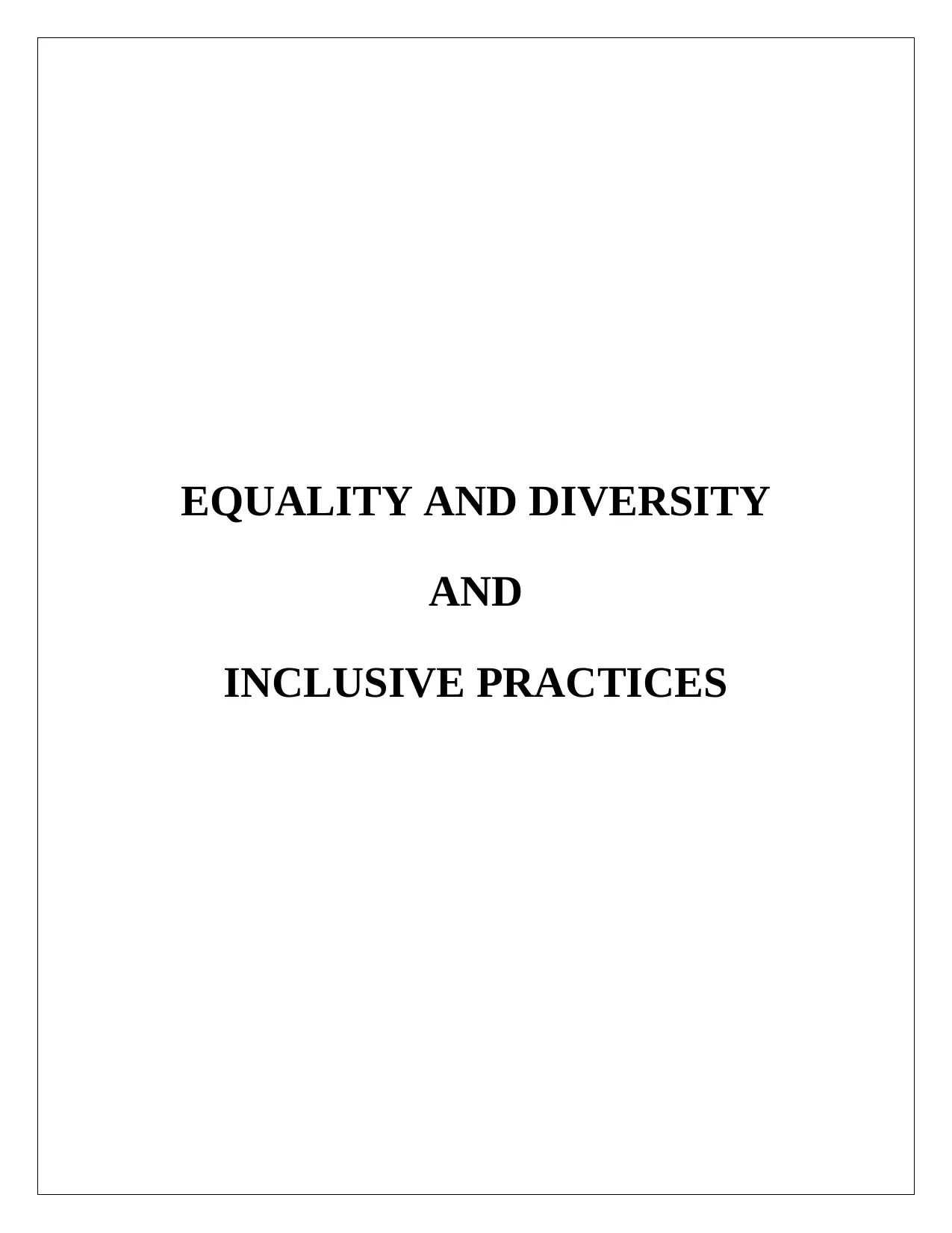
EQUALITY AND DIVERSITY
AND
INCLUSIVE PRACTICES
AND
INCLUSIVE PRACTICES
Paraphrase This Document
Need a fresh take? Get an instant paraphrase of this document with our AI Paraphraser
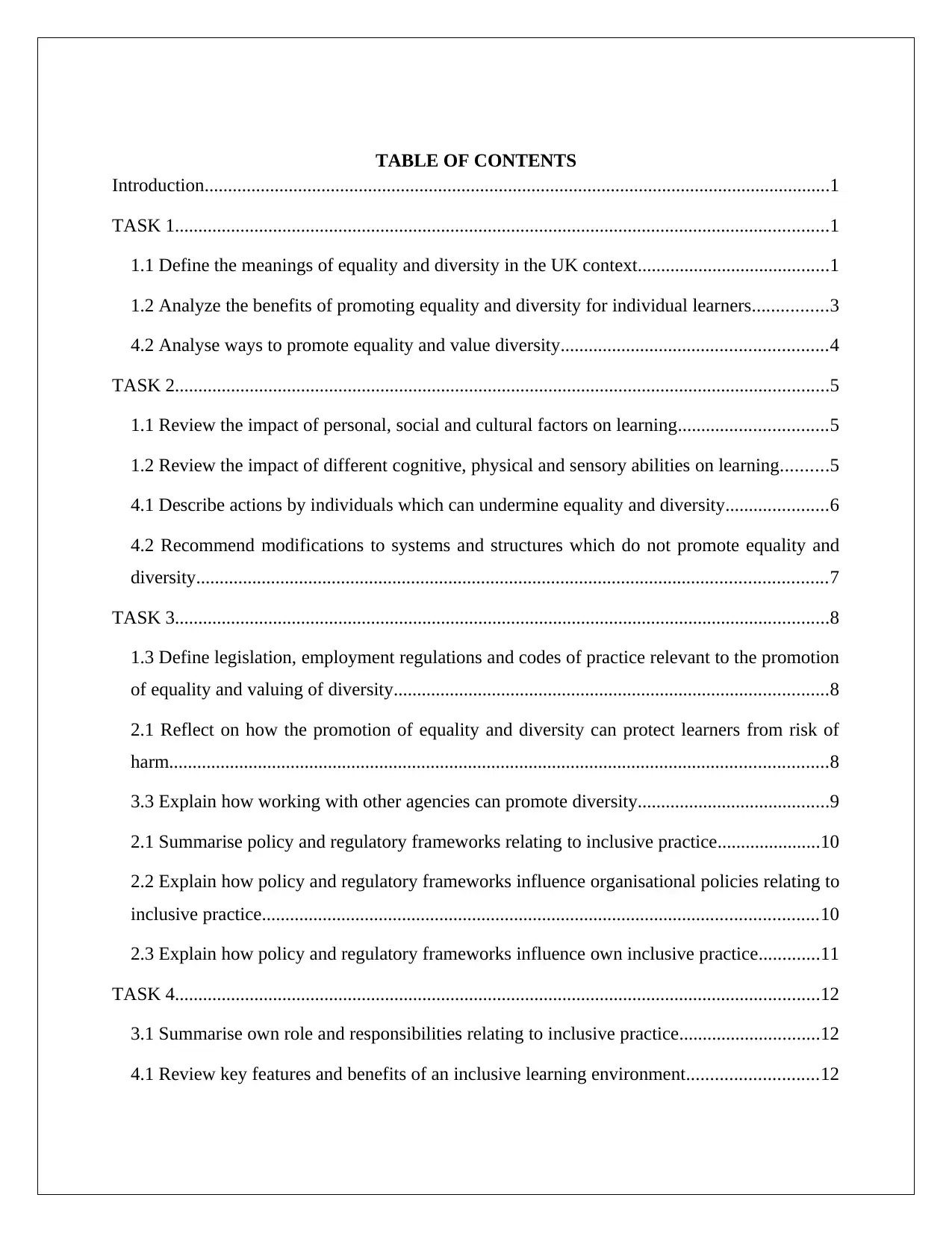
TABLE OF CONTENTS
Introduction......................................................................................................................................1
TASK 1............................................................................................................................................1
1.1 Define the meanings of equality and diversity in the UK context.........................................1
1.2 Analyze the benefits of promoting equality and diversity for individual learners................3
4.2 Analyse ways to promote equality and value diversity.........................................................4
TASK 2............................................................................................................................................5
1.1 Review the impact of personal, social and cultural factors on learning................................5
1.2 Review the impact of different cognitive, physical and sensory abilities on learning..........5
4.1 Describe actions by individuals which can undermine equality and diversity......................6
4.2 Recommend modifications to systems and structures which do not promote equality and
diversity.......................................................................................................................................7
TASK 3............................................................................................................................................8
1.3 Define legislation, employment regulations and codes of practice relevant to the promotion
of equality and valuing of diversity.............................................................................................8
2.1 Reflect on how the promotion of equality and diversity can protect learners from risk of
harm.............................................................................................................................................8
3.3 Explain how working with other agencies can promote diversity.........................................9
2.1 Summarise policy and regulatory frameworks relating to inclusive practice......................10
2.2 Explain how policy and regulatory frameworks influence organisational policies relating to
inclusive practice.......................................................................................................................10
2.3 Explain how policy and regulatory frameworks influence own inclusive practice.............11
TASK 4..........................................................................................................................................12
3.1 Summarise own role and responsibilities relating to inclusive practice..............................12
4.1 Review key features and benefits of an inclusive learning environment............................12
Introduction......................................................................................................................................1
TASK 1............................................................................................................................................1
1.1 Define the meanings of equality and diversity in the UK context.........................................1
1.2 Analyze the benefits of promoting equality and diversity for individual learners................3
4.2 Analyse ways to promote equality and value diversity.........................................................4
TASK 2............................................................................................................................................5
1.1 Review the impact of personal, social and cultural factors on learning................................5
1.2 Review the impact of different cognitive, physical and sensory abilities on learning..........5
4.1 Describe actions by individuals which can undermine equality and diversity......................6
4.2 Recommend modifications to systems and structures which do not promote equality and
diversity.......................................................................................................................................7
TASK 3............................................................................................................................................8
1.3 Define legislation, employment regulations and codes of practice relevant to the promotion
of equality and valuing of diversity.............................................................................................8
2.1 Reflect on how the promotion of equality and diversity can protect learners from risk of
harm.............................................................................................................................................8
3.3 Explain how working with other agencies can promote diversity.........................................9
2.1 Summarise policy and regulatory frameworks relating to inclusive practice......................10
2.2 Explain how policy and regulatory frameworks influence organisational policies relating to
inclusive practice.......................................................................................................................10
2.3 Explain how policy and regulatory frameworks influence own inclusive practice.............11
TASK 4..........................................................................................................................................12
3.1 Summarise own role and responsibilities relating to inclusive practice..............................12
4.1 Review key features and benefits of an inclusive learning environment............................12
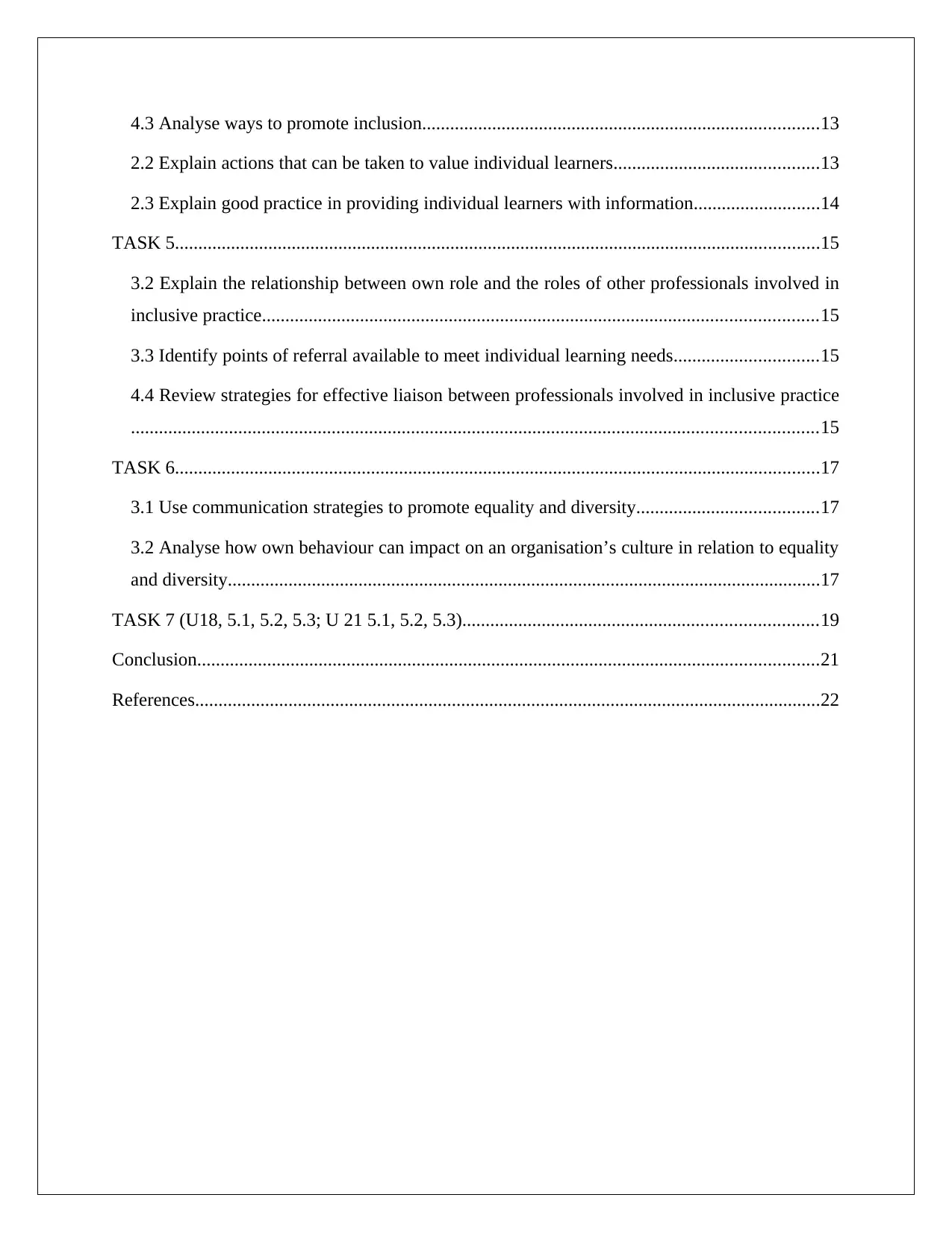
4.3 Analyse ways to promote inclusion.....................................................................................13
2.2 Explain actions that can be taken to value individual learners............................................13
2.3 Explain good practice in providing individual learners with information...........................14
TASK 5..........................................................................................................................................15
3.2 Explain the relationship between own role and the roles of other professionals involved in
inclusive practice.......................................................................................................................15
3.3 Identify points of referral available to meet individual learning needs...............................15
4.4 Review strategies for effective liaison between professionals involved in inclusive practice
...................................................................................................................................................15
TASK 6..........................................................................................................................................17
3.1 Use communication strategies to promote equality and diversity.......................................17
3.2 Analyse how own behaviour can impact on an organisation’s culture in relation to equality
and diversity...............................................................................................................................17
TASK 7 (U18, 5.1, 5.2, 5.3; U 21 5.1, 5.2, 5.3)............................................................................19
Conclusion.....................................................................................................................................21
References......................................................................................................................................22
2.2 Explain actions that can be taken to value individual learners............................................13
2.3 Explain good practice in providing individual learners with information...........................14
TASK 5..........................................................................................................................................15
3.2 Explain the relationship between own role and the roles of other professionals involved in
inclusive practice.......................................................................................................................15
3.3 Identify points of referral available to meet individual learning needs...............................15
4.4 Review strategies for effective liaison between professionals involved in inclusive practice
...................................................................................................................................................15
TASK 6..........................................................................................................................................17
3.1 Use communication strategies to promote equality and diversity.......................................17
3.2 Analyse how own behaviour can impact on an organisation’s culture in relation to equality
and diversity...............................................................................................................................17
TASK 7 (U18, 5.1, 5.2, 5.3; U 21 5.1, 5.2, 5.3)............................................................................19
Conclusion.....................................................................................................................................21
References......................................................................................................................................22
⊘ This is a preview!⊘
Do you want full access?
Subscribe today to unlock all pages.

Trusted by 1+ million students worldwide
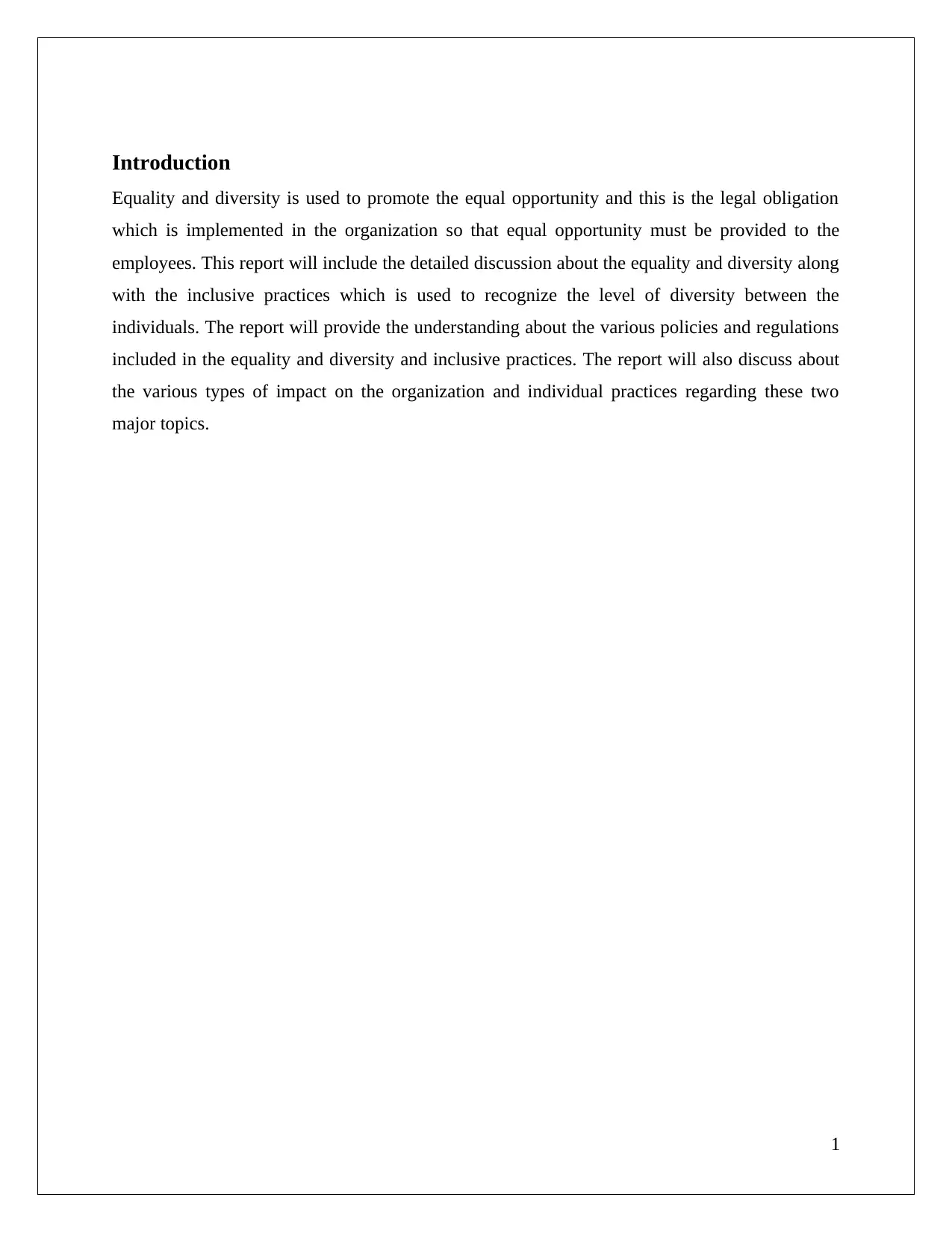
Introduction
Equality and diversity is used to promote the equal opportunity and this is the legal obligation
which is implemented in the organization so that equal opportunity must be provided to the
employees. This report will include the detailed discussion about the equality and diversity along
with the inclusive practices which is used to recognize the level of diversity between the
individuals. The report will provide the understanding about the various policies and regulations
included in the equality and diversity and inclusive practices. The report will also discuss about
the various types of impact on the organization and individual practices regarding these two
major topics.
1
Equality and diversity is used to promote the equal opportunity and this is the legal obligation
which is implemented in the organization so that equal opportunity must be provided to the
employees. This report will include the detailed discussion about the equality and diversity along
with the inclusive practices which is used to recognize the level of diversity between the
individuals. The report will provide the understanding about the various policies and regulations
included in the equality and diversity and inclusive practices. The report will also discuss about
the various types of impact on the organization and individual practices regarding these two
major topics.
1
Paraphrase This Document
Need a fresh take? Get an instant paraphrase of this document with our AI Paraphraser
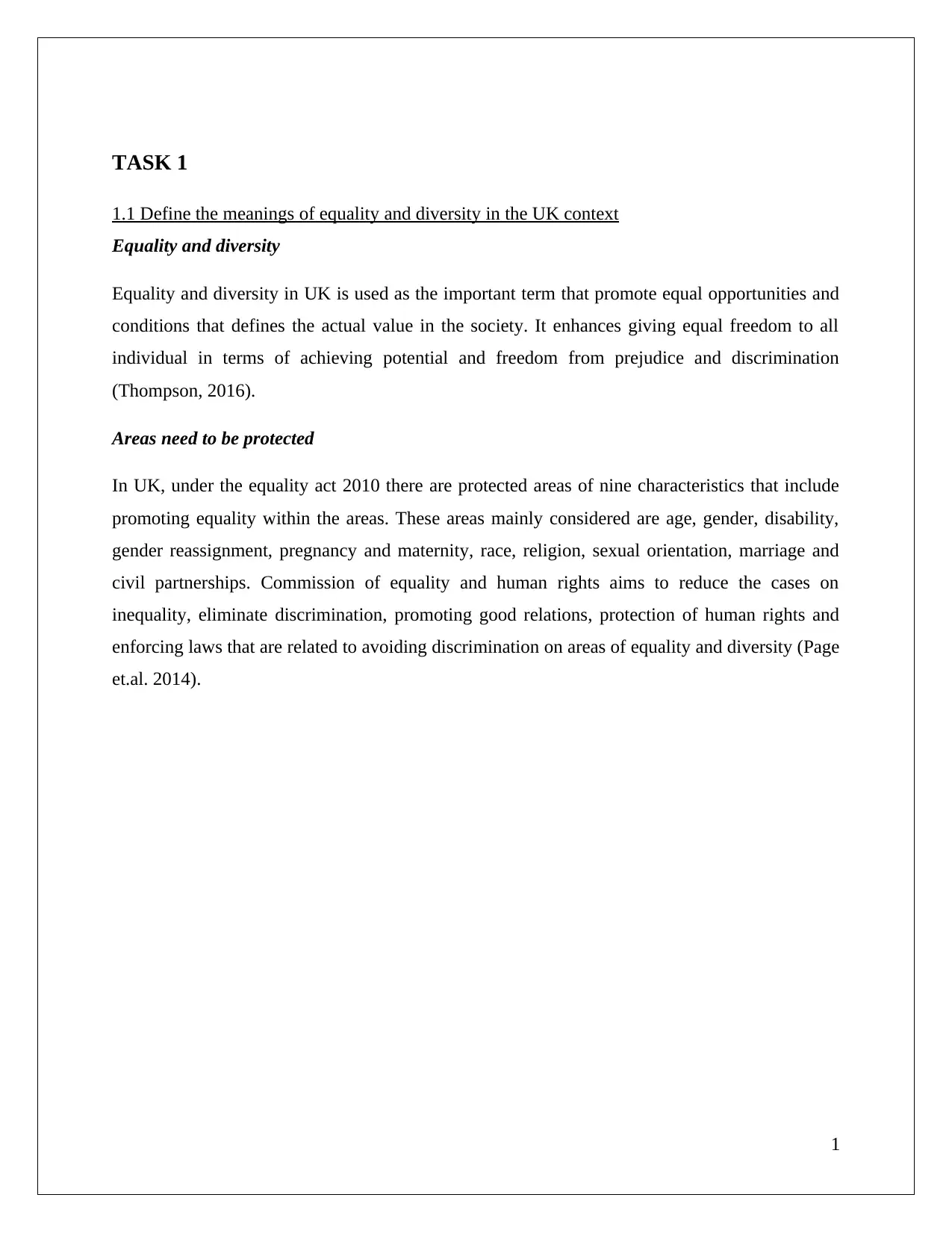
TASK 1
1.1 Define the meanings of equality and diversity in the UK context
Equality and diversity
Equality and diversity in UK is used as the important term that promote equal opportunities and
conditions that defines the actual value in the society. It enhances giving equal freedom to all
individual in terms of achieving potential and freedom from prejudice and discrimination
(Thompson, 2016).
Areas need to be protected
In UK, under the equality act 2010 there are protected areas of nine characteristics that include
promoting equality within the areas. These areas mainly considered are age, gender, disability,
gender reassignment, pregnancy and maternity, race, religion, sexual orientation, marriage and
civil partnerships. Commission of equality and human rights aims to reduce the cases on
inequality, eliminate discrimination, promoting good relations, protection of human rights and
enforcing laws that are related to avoiding discrimination on areas of equality and diversity (Page
et.al. 2014).
1
1.1 Define the meanings of equality and diversity in the UK context
Equality and diversity
Equality and diversity in UK is used as the important term that promote equal opportunities and
conditions that defines the actual value in the society. It enhances giving equal freedom to all
individual in terms of achieving potential and freedom from prejudice and discrimination
(Thompson, 2016).
Areas need to be protected
In UK, under the equality act 2010 there are protected areas of nine characteristics that include
promoting equality within the areas. These areas mainly considered are age, gender, disability,
gender reassignment, pregnancy and maternity, race, religion, sexual orientation, marriage and
civil partnerships. Commission of equality and human rights aims to reduce the cases on
inequality, eliminate discrimination, promoting good relations, protection of human rights and
enforcing laws that are related to avoiding discrimination on areas of equality and diversity (Page
et.al. 2014).
1
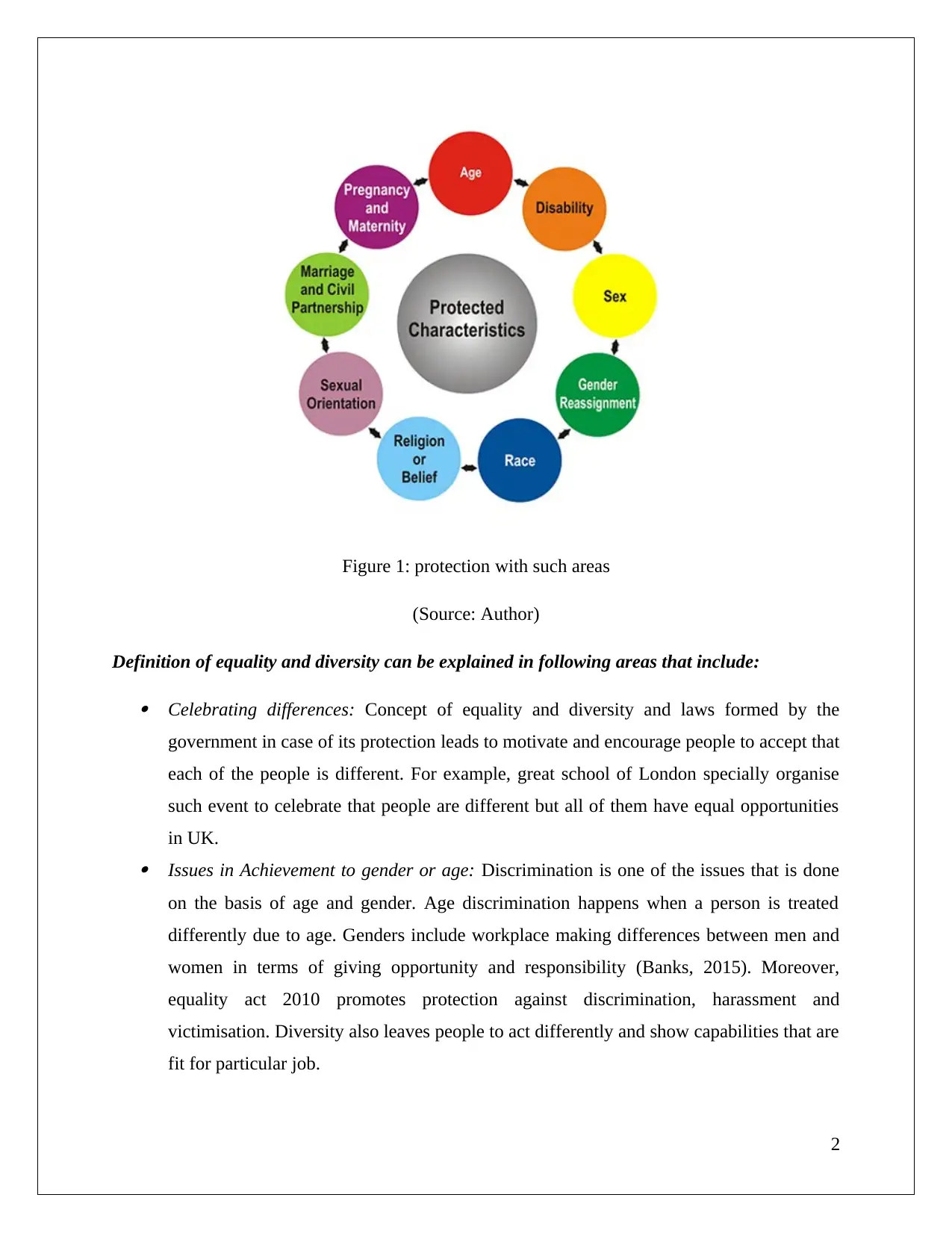
Figure 1: protection with such areas
(Source: Author)
Definition of equality and diversity can be explained in following areas that include:
Celebrating differences: Concept of equality and diversity and laws formed by the
government in case of its protection leads to motivate and encourage people to accept that
each of the people is different. For example, great school of London specially organise
such event to celebrate that people are different but all of them have equal opportunities
in UK. Issues in Achievement to gender or age: Discrimination is one of the issues that is done
on the basis of age and gender. Age discrimination happens when a person is treated
differently due to age. Genders include workplace making differences between men and
women in terms of giving opportunity and responsibility (Banks, 2015). Moreover,
equality act 2010 promotes protection against discrimination, harassment and
victimisation. Diversity also leaves people to act differently and show capabilities that are
fit for particular job.
2
(Source: Author)
Definition of equality and diversity can be explained in following areas that include:
Celebrating differences: Concept of equality and diversity and laws formed by the
government in case of its protection leads to motivate and encourage people to accept that
each of the people is different. For example, great school of London specially organise
such event to celebrate that people are different but all of them have equal opportunities
in UK. Issues in Achievement to gender or age: Discrimination is one of the issues that is done
on the basis of age and gender. Age discrimination happens when a person is treated
differently due to age. Genders include workplace making differences between men and
women in terms of giving opportunity and responsibility (Banks, 2015). Moreover,
equality act 2010 promotes protection against discrimination, harassment and
victimisation. Diversity also leaves people to act differently and show capabilities that are
fit for particular job.
2
⊘ This is a preview!⊘
Do you want full access?
Subscribe today to unlock all pages.

Trusted by 1+ million students worldwide
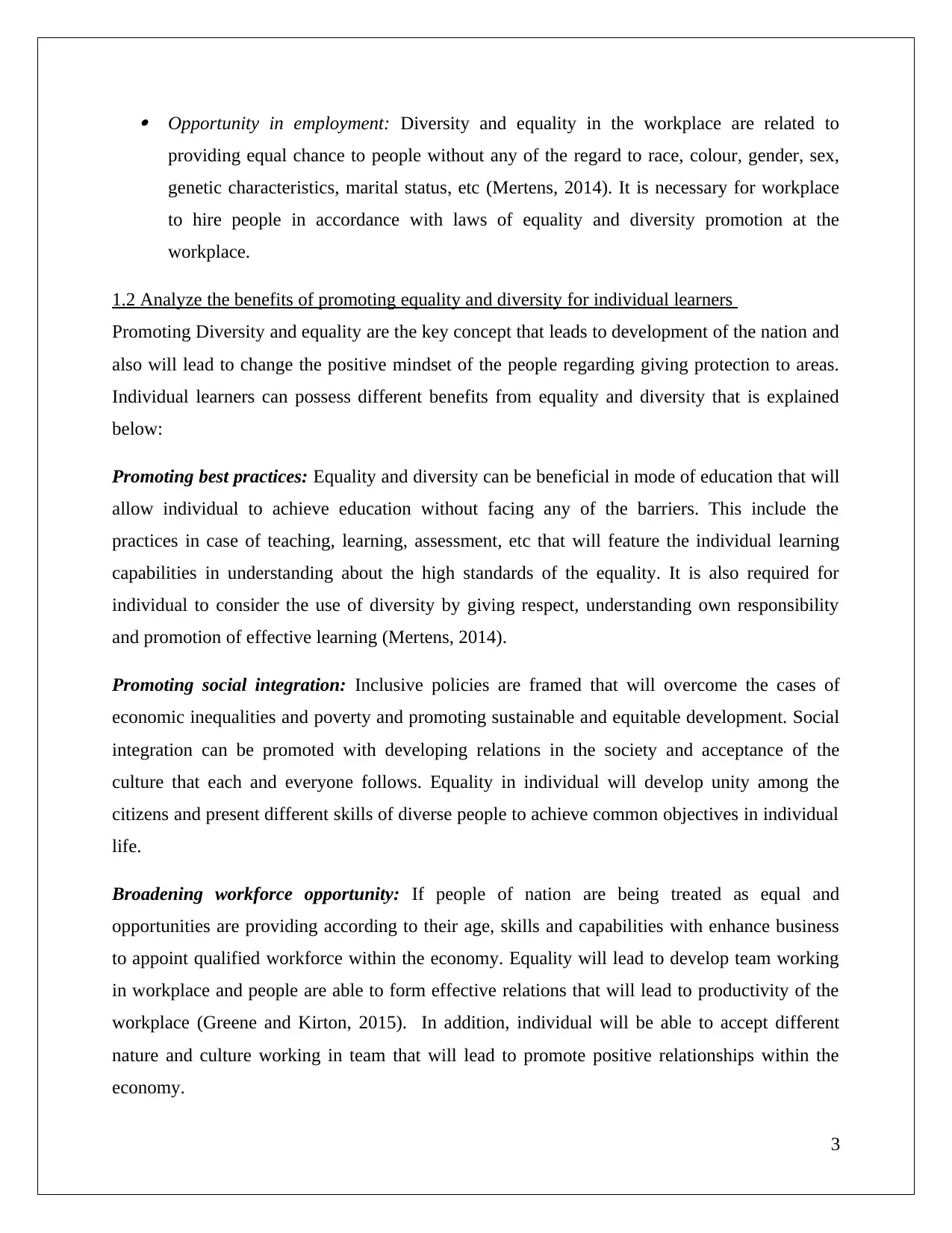
Opportunity in employment: Diversity and equality in the workplace are related to
providing equal chance to people without any of the regard to race, colour, gender, sex,
genetic characteristics, marital status, etc (Mertens, 2014). It is necessary for workplace
to hire people in accordance with laws of equality and diversity promotion at the
workplace.
1.2 Analyze the benefits of promoting equality and diversity for individual learners
Promoting Diversity and equality are the key concept that leads to development of the nation and
also will lead to change the positive mindset of the people regarding giving protection to areas.
Individual learners can possess different benefits from equality and diversity that is explained
below:
Promoting best practices: Equality and diversity can be beneficial in mode of education that will
allow individual to achieve education without facing any of the barriers. This include the
practices in case of teaching, learning, assessment, etc that will feature the individual learning
capabilities in understanding about the high standards of the equality. It is also required for
individual to consider the use of diversity by giving respect, understanding own responsibility
and promotion of effective learning (Mertens, 2014).
Promoting social integration: Inclusive policies are framed that will overcome the cases of
economic inequalities and poverty and promoting sustainable and equitable development. Social
integration can be promoted with developing relations in the society and acceptance of the
culture that each and everyone follows. Equality in individual will develop unity among the
citizens and present different skills of diverse people to achieve common objectives in individual
life.
Broadening workforce opportunity: If people of nation are being treated as equal and
opportunities are providing according to their age, skills and capabilities with enhance business
to appoint qualified workforce within the economy. Equality will lead to develop team working
in workplace and people are able to form effective relations that will lead to productivity of the
workplace (Greene and Kirton, 2015). In addition, individual will be able to accept different
nature and culture working in team that will lead to promote positive relationships within the
economy.
3
providing equal chance to people without any of the regard to race, colour, gender, sex,
genetic characteristics, marital status, etc (Mertens, 2014). It is necessary for workplace
to hire people in accordance with laws of equality and diversity promotion at the
workplace.
1.2 Analyze the benefits of promoting equality and diversity for individual learners
Promoting Diversity and equality are the key concept that leads to development of the nation and
also will lead to change the positive mindset of the people regarding giving protection to areas.
Individual learners can possess different benefits from equality and diversity that is explained
below:
Promoting best practices: Equality and diversity can be beneficial in mode of education that will
allow individual to achieve education without facing any of the barriers. This include the
practices in case of teaching, learning, assessment, etc that will feature the individual learning
capabilities in understanding about the high standards of the equality. It is also required for
individual to consider the use of diversity by giving respect, understanding own responsibility
and promotion of effective learning (Mertens, 2014).
Promoting social integration: Inclusive policies are framed that will overcome the cases of
economic inequalities and poverty and promoting sustainable and equitable development. Social
integration can be promoted with developing relations in the society and acceptance of the
culture that each and everyone follows. Equality in individual will develop unity among the
citizens and present different skills of diverse people to achieve common objectives in individual
life.
Broadening workforce opportunity: If people of nation are being treated as equal and
opportunities are providing according to their age, skills and capabilities with enhance business
to appoint qualified workforce within the economy. Equality will lead to develop team working
in workplace and people are able to form effective relations that will lead to productivity of the
workplace (Greene and Kirton, 2015). In addition, individual will be able to accept different
nature and culture working in team that will lead to promote positive relationships within the
economy.
3
Paraphrase This Document
Need a fresh take? Get an instant paraphrase of this document with our AI Paraphraser
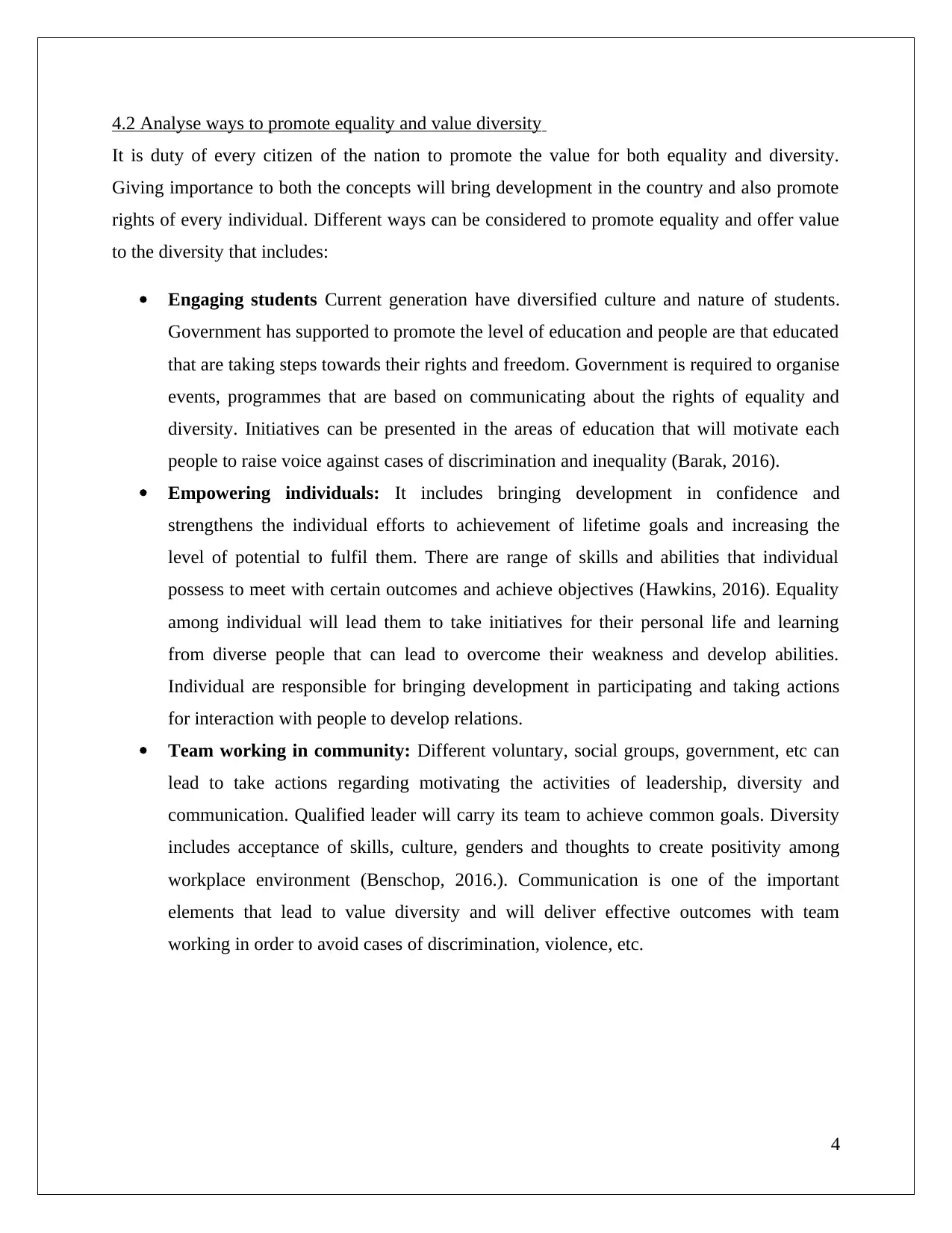
4.2 Analyse ways to promote equality and value diversity
It is duty of every citizen of the nation to promote the value for both equality and diversity.
Giving importance to both the concepts will bring development in the country and also promote
rights of every individual. Different ways can be considered to promote equality and offer value
to the diversity that includes:
Engaging students Current generation have diversified culture and nature of students.
Government has supported to promote the level of education and people are that educated
that are taking steps towards their rights and freedom. Government is required to organise
events, programmes that are based on communicating about the rights of equality and
diversity. Initiatives can be presented in the areas of education that will motivate each
people to raise voice against cases of discrimination and inequality (Barak, 2016).
Empowering individuals: It includes bringing development in confidence and
strengthens the individual efforts to achievement of lifetime goals and increasing the
level of potential to fulfil them. There are range of skills and abilities that individual
possess to meet with certain outcomes and achieve objectives (Hawkins, 2016). Equality
among individual will lead them to take initiatives for their personal life and learning
from diverse people that can lead to overcome their weakness and develop abilities.
Individual are responsible for bringing development in participating and taking actions
for interaction with people to develop relations.
Team working in community: Different voluntary, social groups, government, etc can
lead to take actions regarding motivating the activities of leadership, diversity and
communication. Qualified leader will carry its team to achieve common goals. Diversity
includes acceptance of skills, culture, genders and thoughts to create positivity among
workplace environment (Benschop, 2016.). Communication is one of the important
elements that lead to value diversity and will deliver effective outcomes with team
working in order to avoid cases of discrimination, violence, etc.
4
It is duty of every citizen of the nation to promote the value for both equality and diversity.
Giving importance to both the concepts will bring development in the country and also promote
rights of every individual. Different ways can be considered to promote equality and offer value
to the diversity that includes:
Engaging students Current generation have diversified culture and nature of students.
Government has supported to promote the level of education and people are that educated
that are taking steps towards their rights and freedom. Government is required to organise
events, programmes that are based on communicating about the rights of equality and
diversity. Initiatives can be presented in the areas of education that will motivate each
people to raise voice against cases of discrimination and inequality (Barak, 2016).
Empowering individuals: It includes bringing development in confidence and
strengthens the individual efforts to achievement of lifetime goals and increasing the
level of potential to fulfil them. There are range of skills and abilities that individual
possess to meet with certain outcomes and achieve objectives (Hawkins, 2016). Equality
among individual will lead them to take initiatives for their personal life and learning
from diverse people that can lead to overcome their weakness and develop abilities.
Individual are responsible for bringing development in participating and taking actions
for interaction with people to develop relations.
Team working in community: Different voluntary, social groups, government, etc can
lead to take actions regarding motivating the activities of leadership, diversity and
communication. Qualified leader will carry its team to achieve common goals. Diversity
includes acceptance of skills, culture, genders and thoughts to create positivity among
workplace environment (Benschop, 2016.). Communication is one of the important
elements that lead to value diversity and will deliver effective outcomes with team
working in order to avoid cases of discrimination, violence, etc.
4
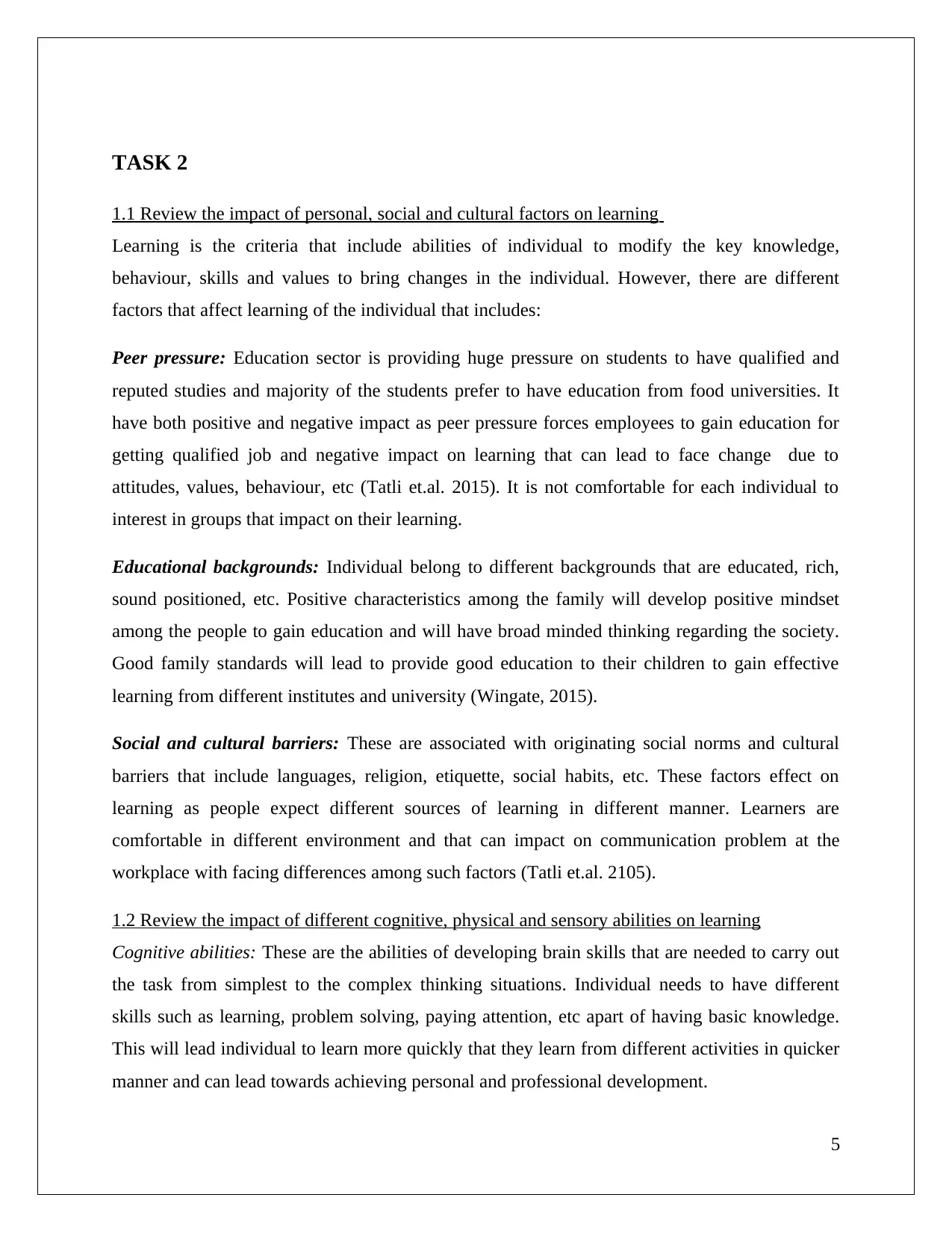
TASK 2
1.1 Review the impact of personal, social and cultural factors on learning
Learning is the criteria that include abilities of individual to modify the key knowledge,
behaviour, skills and values to bring changes in the individual. However, there are different
factors that affect learning of the individual that includes:
Peer pressure: Education sector is providing huge pressure on students to have qualified and
reputed studies and majority of the students prefer to have education from food universities. It
have both positive and negative impact as peer pressure forces employees to gain education for
getting qualified job and negative impact on learning that can lead to face change due to
attitudes, values, behaviour, etc (Tatli et.al. 2015). It is not comfortable for each individual to
interest in groups that impact on their learning.
Educational backgrounds: Individual belong to different backgrounds that are educated, rich,
sound positioned, etc. Positive characteristics among the family will develop positive mindset
among the people to gain education and will have broad minded thinking regarding the society.
Good family standards will lead to provide good education to their children to gain effective
learning from different institutes and university (Wingate, 2015).
Social and cultural barriers: These are associated with originating social norms and cultural
barriers that include languages, religion, etiquette, social habits, etc. These factors effect on
learning as people expect different sources of learning in different manner. Learners are
comfortable in different environment and that can impact on communication problem at the
workplace with facing differences among such factors (Tatli et.al. 2105).
1.2 Review the impact of different cognitive, physical and sensory abilities on learning
Cognitive abilities: These are the abilities of developing brain skills that are needed to carry out
the task from simplest to the complex thinking situations. Individual needs to have different
skills such as learning, problem solving, paying attention, etc apart of having basic knowledge.
This will lead individual to learn more quickly that they learn from different activities in quicker
manner and can lead towards achieving personal and professional development.
5
1.1 Review the impact of personal, social and cultural factors on learning
Learning is the criteria that include abilities of individual to modify the key knowledge,
behaviour, skills and values to bring changes in the individual. However, there are different
factors that affect learning of the individual that includes:
Peer pressure: Education sector is providing huge pressure on students to have qualified and
reputed studies and majority of the students prefer to have education from food universities. It
have both positive and negative impact as peer pressure forces employees to gain education for
getting qualified job and negative impact on learning that can lead to face change due to
attitudes, values, behaviour, etc (Tatli et.al. 2015). It is not comfortable for each individual to
interest in groups that impact on their learning.
Educational backgrounds: Individual belong to different backgrounds that are educated, rich,
sound positioned, etc. Positive characteristics among the family will develop positive mindset
among the people to gain education and will have broad minded thinking regarding the society.
Good family standards will lead to provide good education to their children to gain effective
learning from different institutes and university (Wingate, 2015).
Social and cultural barriers: These are associated with originating social norms and cultural
barriers that include languages, religion, etiquette, social habits, etc. These factors effect on
learning as people expect different sources of learning in different manner. Learners are
comfortable in different environment and that can impact on communication problem at the
workplace with facing differences among such factors (Tatli et.al. 2105).
1.2 Review the impact of different cognitive, physical and sensory abilities on learning
Cognitive abilities: These are the abilities of developing brain skills that are needed to carry out
the task from simplest to the complex thinking situations. Individual needs to have different
skills such as learning, problem solving, paying attention, etc apart of having basic knowledge.
This will lead individual to learn more quickly that they learn from different activities in quicker
manner and can lead towards achieving personal and professional development.
5
⊘ This is a preview!⊘
Do you want full access?
Subscribe today to unlock all pages.

Trusted by 1+ million students worldwide
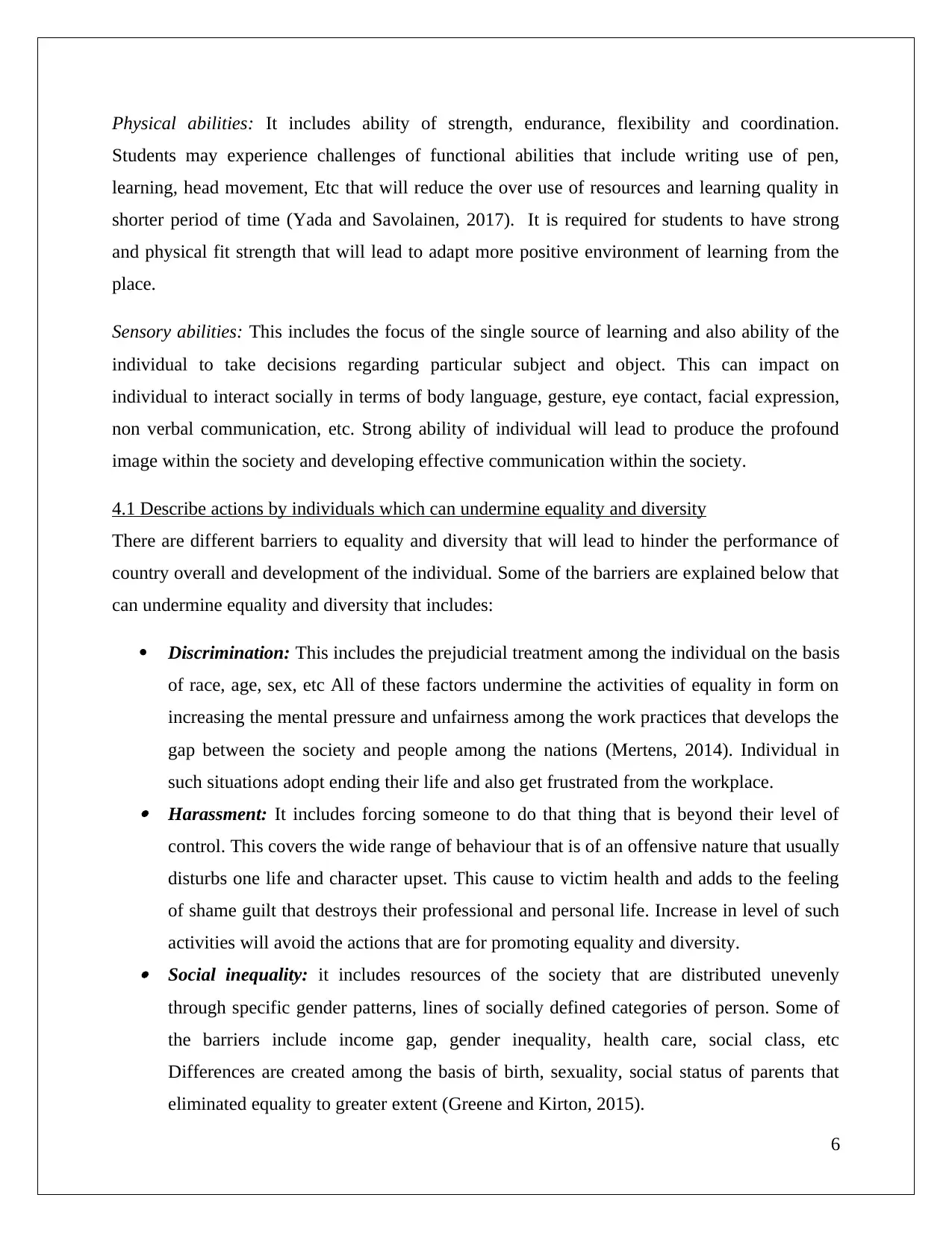
Physical abilities: It includes ability of strength, endurance, flexibility and coordination.
Students may experience challenges of functional abilities that include writing use of pen,
learning, head movement, Etc that will reduce the over use of resources and learning quality in
shorter period of time (Yada and Savolainen, 2017). It is required for students to have strong
and physical fit strength that will lead to adapt more positive environment of learning from the
place.
Sensory abilities: This includes the focus of the single source of learning and also ability of the
individual to take decisions regarding particular subject and object. This can impact on
individual to interact socially in terms of body language, gesture, eye contact, facial expression,
non verbal communication, etc. Strong ability of individual will lead to produce the profound
image within the society and developing effective communication within the society.
4.1 Describe actions by individuals which can undermine equality and diversity
There are different barriers to equality and diversity that will lead to hinder the performance of
country overall and development of the individual. Some of the barriers are explained below that
can undermine equality and diversity that includes:
Discrimination: This includes the prejudicial treatment among the individual on the basis
of race, age, sex, etc All of these factors undermine the activities of equality in form on
increasing the mental pressure and unfairness among the work practices that develops the
gap between the society and people among the nations (Mertens, 2014). Individual in
such situations adopt ending their life and also get frustrated from the workplace. Harassment: It includes forcing someone to do that thing that is beyond their level of
control. This covers the wide range of behaviour that is of an offensive nature that usually
disturbs one life and character upset. This cause to victim health and adds to the feeling
of shame guilt that destroys their professional and personal life. Increase in level of such
activities will avoid the actions that are for promoting equality and diversity. Social inequality: it includes resources of the society that are distributed unevenly
through specific gender patterns, lines of socially defined categories of person. Some of
the barriers include income gap, gender inequality, health care, social class, etc
Differences are created among the basis of birth, sexuality, social status of parents that
eliminated equality to greater extent (Greene and Kirton, 2015).
6
Students may experience challenges of functional abilities that include writing use of pen,
learning, head movement, Etc that will reduce the over use of resources and learning quality in
shorter period of time (Yada and Savolainen, 2017). It is required for students to have strong
and physical fit strength that will lead to adapt more positive environment of learning from the
place.
Sensory abilities: This includes the focus of the single source of learning and also ability of the
individual to take decisions regarding particular subject and object. This can impact on
individual to interact socially in terms of body language, gesture, eye contact, facial expression,
non verbal communication, etc. Strong ability of individual will lead to produce the profound
image within the society and developing effective communication within the society.
4.1 Describe actions by individuals which can undermine equality and diversity
There are different barriers to equality and diversity that will lead to hinder the performance of
country overall and development of the individual. Some of the barriers are explained below that
can undermine equality and diversity that includes:
Discrimination: This includes the prejudicial treatment among the individual on the basis
of race, age, sex, etc All of these factors undermine the activities of equality in form on
increasing the mental pressure and unfairness among the work practices that develops the
gap between the society and people among the nations (Mertens, 2014). Individual in
such situations adopt ending their life and also get frustrated from the workplace. Harassment: It includes forcing someone to do that thing that is beyond their level of
control. This covers the wide range of behaviour that is of an offensive nature that usually
disturbs one life and character upset. This cause to victim health and adds to the feeling
of shame guilt that destroys their professional and personal life. Increase in level of such
activities will avoid the actions that are for promoting equality and diversity. Social inequality: it includes resources of the society that are distributed unevenly
through specific gender patterns, lines of socially defined categories of person. Some of
the barriers include income gap, gender inequality, health care, social class, etc
Differences are created among the basis of birth, sexuality, social status of parents that
eliminated equality to greater extent (Greene and Kirton, 2015).
6
Paraphrase This Document
Need a fresh take? Get an instant paraphrase of this document with our AI Paraphraser
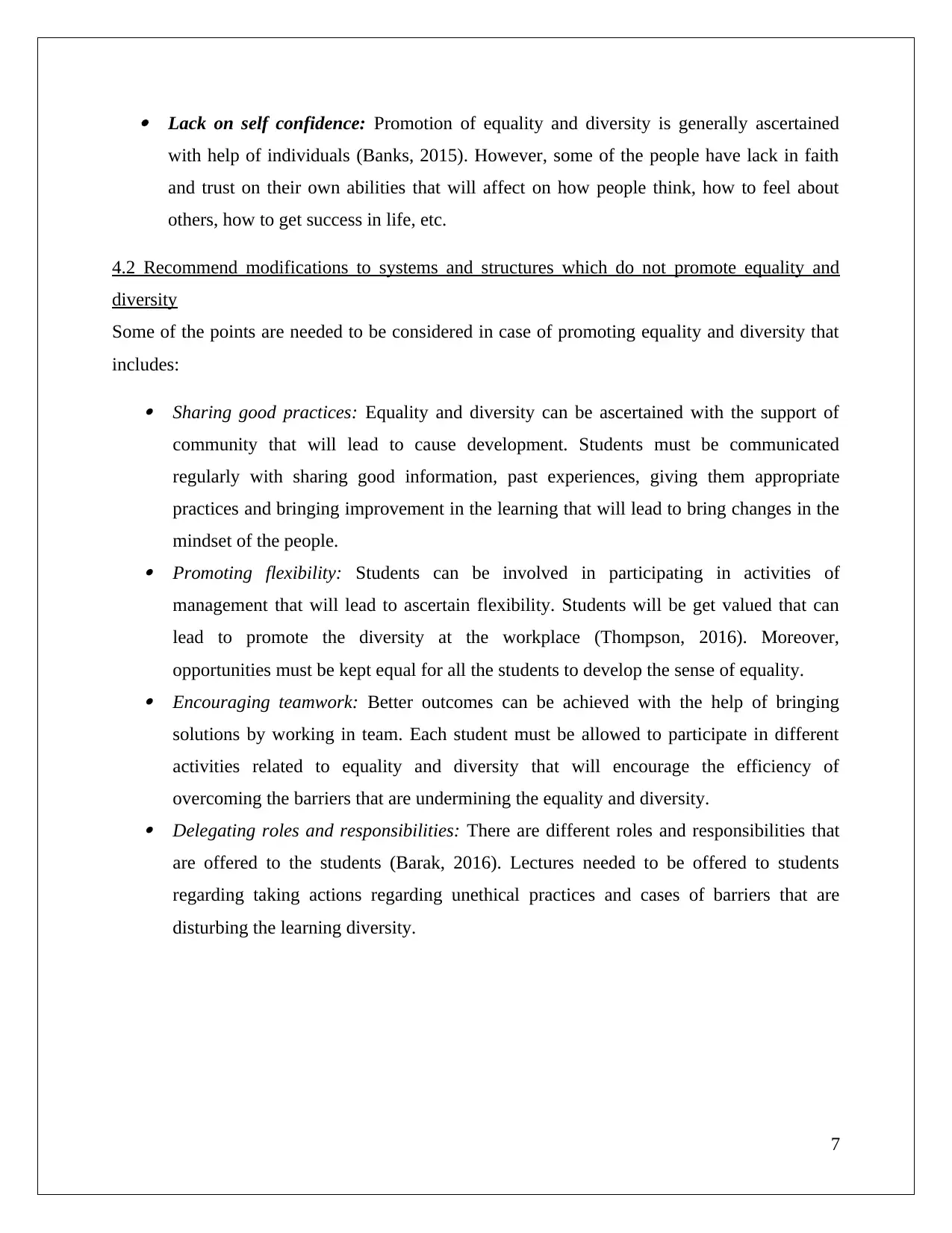
Lack on self confidence: Promotion of equality and diversity is generally ascertained
with help of individuals (Banks, 2015). However, some of the people have lack in faith
and trust on their own abilities that will affect on how people think, how to feel about
others, how to get success in life, etc.
4.2 Recommend modifications to systems and structures which do not promote equality and
diversity
Some of the points are needed to be considered in case of promoting equality and diversity that
includes: Sharing good practices: Equality and diversity can be ascertained with the support of
community that will lead to cause development. Students must be communicated
regularly with sharing good information, past experiences, giving them appropriate
practices and bringing improvement in the learning that will lead to bring changes in the
mindset of the people. Promoting flexibility: Students can be involved in participating in activities of
management that will lead to ascertain flexibility. Students will be get valued that can
lead to promote the diversity at the workplace (Thompson, 2016). Moreover,
opportunities must be kept equal for all the students to develop the sense of equality. Encouraging teamwork: Better outcomes can be achieved with the help of bringing
solutions by working in team. Each student must be allowed to participate in different
activities related to equality and diversity that will encourage the efficiency of
overcoming the barriers that are undermining the equality and diversity. Delegating roles and responsibilities: There are different roles and responsibilities that
are offered to the students (Barak, 2016). Lectures needed to be offered to students
regarding taking actions regarding unethical practices and cases of barriers that are
disturbing the learning diversity.
7
with help of individuals (Banks, 2015). However, some of the people have lack in faith
and trust on their own abilities that will affect on how people think, how to feel about
others, how to get success in life, etc.
4.2 Recommend modifications to systems and structures which do not promote equality and
diversity
Some of the points are needed to be considered in case of promoting equality and diversity that
includes: Sharing good practices: Equality and diversity can be ascertained with the support of
community that will lead to cause development. Students must be communicated
regularly with sharing good information, past experiences, giving them appropriate
practices and bringing improvement in the learning that will lead to bring changes in the
mindset of the people. Promoting flexibility: Students can be involved in participating in activities of
management that will lead to ascertain flexibility. Students will be get valued that can
lead to promote the diversity at the workplace (Thompson, 2016). Moreover,
opportunities must be kept equal for all the students to develop the sense of equality. Encouraging teamwork: Better outcomes can be achieved with the help of bringing
solutions by working in team. Each student must be allowed to participate in different
activities related to equality and diversity that will encourage the efficiency of
overcoming the barriers that are undermining the equality and diversity. Delegating roles and responsibilities: There are different roles and responsibilities that
are offered to the students (Barak, 2016). Lectures needed to be offered to students
regarding taking actions regarding unethical practices and cases of barriers that are
disturbing the learning diversity.
7
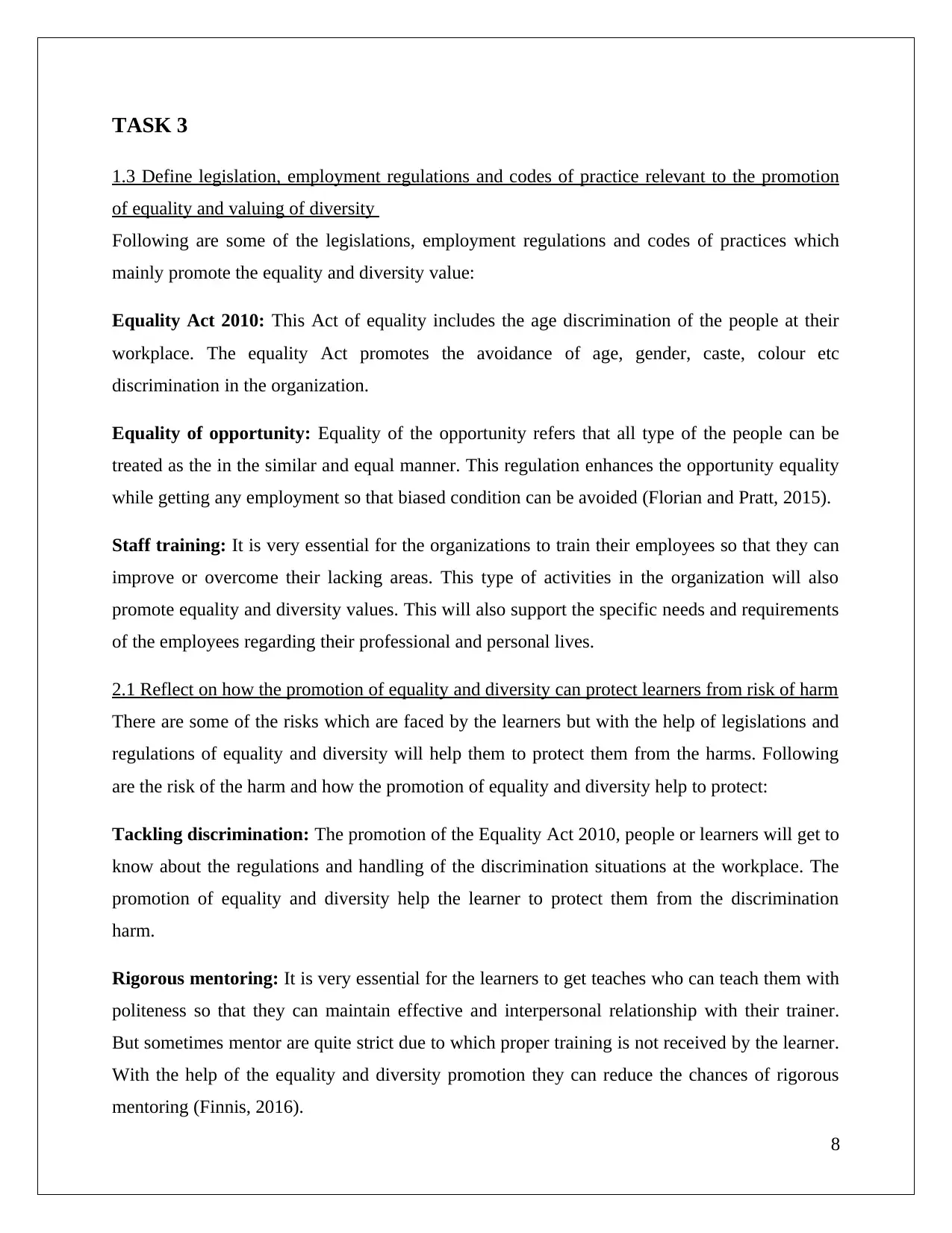
TASK 3
1.3 Define legislation, employment regulations and codes of practice relevant to the promotion
of equality and valuing of diversity
Following are some of the legislations, employment regulations and codes of practices which
mainly promote the equality and diversity value:
Equality Act 2010: This Act of equality includes the age discrimination of the people at their
workplace. The equality Act promotes the avoidance of age, gender, caste, colour etc
discrimination in the organization.
Equality of opportunity: Equality of the opportunity refers that all type of the people can be
treated as the in the similar and equal manner. This regulation enhances the opportunity equality
while getting any employment so that biased condition can be avoided (Florian and Pratt, 2015).
Staff training: It is very essential for the organizations to train their employees so that they can
improve or overcome their lacking areas. This type of activities in the organization will also
promote equality and diversity values. This will also support the specific needs and requirements
of the employees regarding their professional and personal lives.
2.1 Reflect on how the promotion of equality and diversity can protect learners from risk of harm
There are some of the risks which are faced by the learners but with the help of legislations and
regulations of equality and diversity will help them to protect them from the harms. Following
are the risk of the harm and how the promotion of equality and diversity help to protect:
Tackling discrimination: The promotion of the Equality Act 2010, people or learners will get to
know about the regulations and handling of the discrimination situations at the workplace. The
promotion of equality and diversity help the learner to protect them from the discrimination
harm.
Rigorous mentoring: It is very essential for the learners to get teaches who can teach them with
politeness so that they can maintain effective and interpersonal relationship with their trainer.
But sometimes mentor are quite strict due to which proper training is not received by the learner.
With the help of the equality and diversity promotion they can reduce the chances of rigorous
mentoring (Finnis, 2016).
8
1.3 Define legislation, employment regulations and codes of practice relevant to the promotion
of equality and valuing of diversity
Following are some of the legislations, employment regulations and codes of practices which
mainly promote the equality and diversity value:
Equality Act 2010: This Act of equality includes the age discrimination of the people at their
workplace. The equality Act promotes the avoidance of age, gender, caste, colour etc
discrimination in the organization.
Equality of opportunity: Equality of the opportunity refers that all type of the people can be
treated as the in the similar and equal manner. This regulation enhances the opportunity equality
while getting any employment so that biased condition can be avoided (Florian and Pratt, 2015).
Staff training: It is very essential for the organizations to train their employees so that they can
improve or overcome their lacking areas. This type of activities in the organization will also
promote equality and diversity values. This will also support the specific needs and requirements
of the employees regarding their professional and personal lives.
2.1 Reflect on how the promotion of equality and diversity can protect learners from risk of harm
There are some of the risks which are faced by the learners but with the help of legislations and
regulations of equality and diversity will help them to protect them from the harms. Following
are the risk of the harm and how the promotion of equality and diversity help to protect:
Tackling discrimination: The promotion of the Equality Act 2010, people or learners will get to
know about the regulations and handling of the discrimination situations at the workplace. The
promotion of equality and diversity help the learner to protect them from the discrimination
harm.
Rigorous mentoring: It is very essential for the learners to get teaches who can teach them with
politeness so that they can maintain effective and interpersonal relationship with their trainer.
But sometimes mentor are quite strict due to which proper training is not received by the learner.
With the help of the equality and diversity promotion they can reduce the chances of rigorous
mentoring (Finnis, 2016).
8
⊘ This is a preview!⊘
Do you want full access?
Subscribe today to unlock all pages.

Trusted by 1+ million students worldwide
1 out of 28
Related Documents
Your All-in-One AI-Powered Toolkit for Academic Success.
+13062052269
info@desklib.com
Available 24*7 on WhatsApp / Email
![[object Object]](/_next/static/media/star-bottom.7253800d.svg)
Unlock your academic potential
Copyright © 2020–2025 A2Z Services. All Rights Reserved. Developed and managed by ZUCOL.




